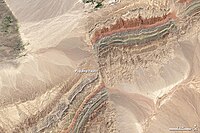
Photo from wikipedia
Foreshocks are not uncommon prior to large earthquakes, but their physical mechanism controversial. Two interpretations have been put forward: 1. foreshocks are driven by aseismic nucleation; 2. foreshocks are cascades,… Click to show full abstract
Foreshocks are not uncommon prior to large earthquakes, but their physical mechanism controversial. Two interpretations have been put forward: 1. foreshocks are driven by aseismic nucleation; 2. foreshocks are cascades, with each event triggered by earlier ones. Here we study seismic cycles on faults with fractal roughness at wavelengths exceeding the nucleation length. We perform 2-D quasi-dynamic simulations of frictionally uniform rate-state faults. Roughness leads to a range of slip behavior between system-size ruptures, including widespread creep, localized slow slip, and microseismicity. These processes are explained by spatial variations in normal stress (σ) caused by roughness: regions with low σ tend to creep, while high σ regions remain locked until they break seismically. Foreshocks and mainshocks both initiate from the rupture of locked asperities, but mainshocks preferentially start on stronger asperities. The preseismic phase is characterized by a feedback between creep and foreshocks: episodic seismic bursts break groups of nearby asperities, causing creep to accelerate, which in turns loads other asperities leading to further foreshocks. A simple analytical treatment of this mutual stress transfer, confirmed by simulations, predicts slip velocities and seismicity rates increase as 1/t, where t is the time to the mainshock. The model reproduces the observed migration of foreshocks towards the mainshock hypocenter, foreshock locations consistent with static stress changes, and the 1/t acceleration in stacked catalogs. Instead of interpreting foreshocks as either driven by coseismic stress changes or by creep, we propose that earthquake nucleation on rough faults is driven by the feedback between the two.
Journal Title: Journal of Geophysical Research
Year Published: 2021
Link to full text (if available)
Share on Social Media: Sign Up to like & get
recommendations!